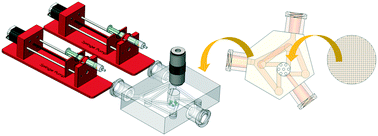Patterned microfluidic devices for rapid screening of metal–organic frameworks yield insights into polymorphism and non-monotonic growth†
Abstract
Metal–organic frameworks (MOFs) are porous crystalline structures that are composed of coordinated metal ligands and organic linkers. Due to their high porosity, ultra-high surface-to-volume ratio, and chemical and structural flexibility, MOFs have numerous applications. MOFs are primarily synthesized in batch reactors under harsh conditions and long synthesis times. The continuous depletion of metal ligands and linkers in batch processes affects the kinetics of the oligomerization reaction and, hence, their nucleation and growth rates. Therefore, the existing screening systems that rely on batch processes, such as microtiter plates and droplet-based microfluidics, do not provide reliable nucleation and growth rate data. Significant challenges still exist for developing a relatively inexpensive, safe, and readily scalable screening device and ensuring consistency of results before scaling up. Here, we have designed patterned-surface microfluidic devices for continuous-flow synthesis of MOFs that allow effective and rapid screening of synthesis conditions. The patterned surface reduces the induction time of MOF synthesis for rapid screening while providing support to capture MOF crystals for growth measurements. The efficacy of the continuous-flow patterned microfluidic device to screen polymorphs, morphology, and growth rates is demonstrated for the HKUST-1 MOF. The effects of solvent composition and pH modulators on the morphology, polymorphs, and size distribution of HKUST-1 are evaluated using the patterned microfluidic device. Additionally, a time-resolved FT-IR analysis coupled with the patterned microfluidic device provides quantitative insights into the non-monotonic growth of MOF crystals with respect to the progression of the bulk oligomerization reaction. The patterned microfluidic device can be used to screen crystals with a longer induction time, such as proteins, covalent-organic frameworks, and MOFs.



 Please wait while we load your content...
Please wait while we load your content...